Garden design lessons from a Texas gravel garden
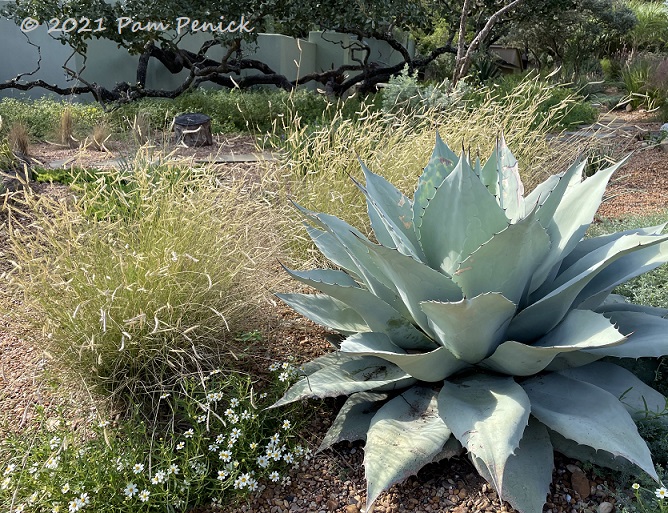
I’m always inspired by Linda Peterson’s low-water gravel garden in San Antonio, which normally is studded with gigantic Weber agaves, sculptural prickly pears, rivers of starfish-shaped soap aloes, and strategic screening shrubs that soften fencing and create a green backdrop for her suburban garden. The epic February freeze swept away much of that — for now — and Linda warned me that her garden would look different when I drove down in late October with Loree Bohl of Danger Garden, visiting from Portland.
It did look a bit different, of course. All Texas gardens do after a week below freezing. But Linda’s leaner garden — still stunning, by the way — revealed more of its design secrets to me this time, and I’m going to share them with you.
Preserve negative space
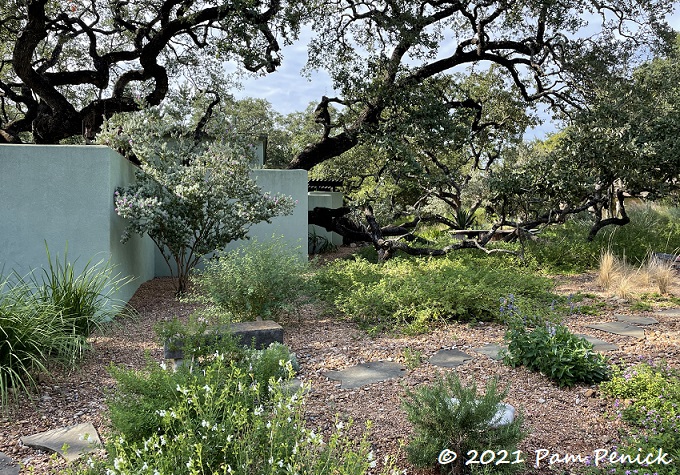
Unplanted space in a gravel garden looks natural and gives plants and people room to “breathe.” Dry gardens like Linda’s benefit from a more open look, replicating the way Mother Nature does it in regions where water is scarce. This doesn’t mean dotting one plant here, one plant there, and calling it done. See how Linda has used a large shrub (cenizo, or Texas ranger) in the corner, with clumps of salvias in the foreground, prostrate rosemary and strappy iris (I think) along the path, and a low groundcover under sprawling live oak limbs. Not too much, but not too little either. When you walk through, you are surrounded by plants but not smothered — a plus in our hot, humid subtropical climate, especially in summer.
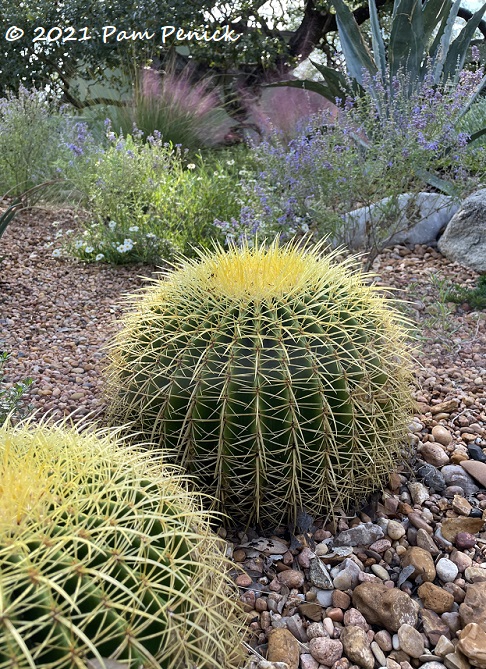
In a sunnier area, golden barrel cactus has room to shine, with blackfoot daisy, Gulf muhly, salvias, and agave in the background. Gravel open space creates a unifying mat around the plants.
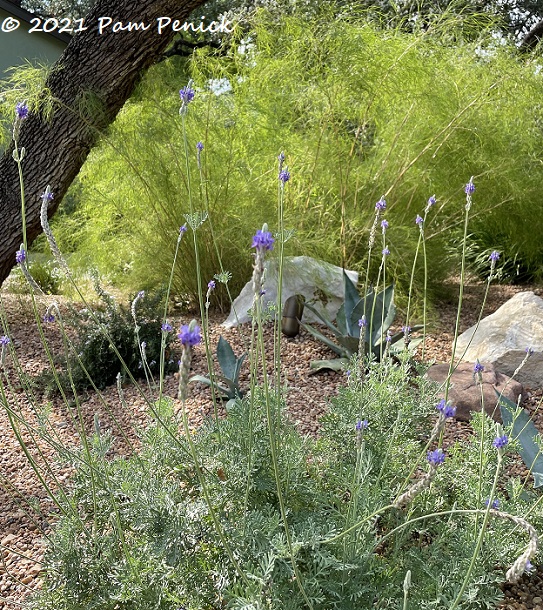
Lavender, agave pups, and bamboo muhly grass mingle but have room to do their thing.
Don’t fight your trees
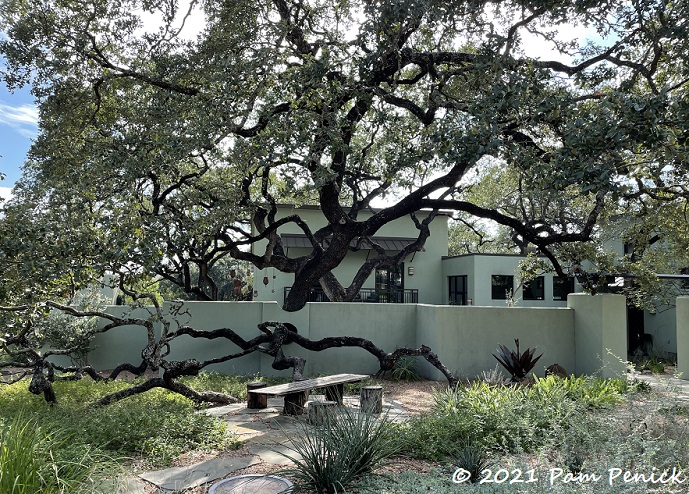
Those of us who garden under trees, especially live oaks, often have a love-hate relationship with them. We treasure their shade and charismatic beauty. But we curse the nonstop litter of leaves, acorns, twigs, galls, and ball moss, not to mention the lack of light essential for growing flowering plants we covet. Linda has given her trees star billing. Her black-limbed, octopus-armed live oaks are sculpturally pruned to perfection. She and husband Carl even built a stucco wall around one huge live oak, encircling a low-growing limb with a porthole opening rather than cutting it off to create a walled courtyard. She grows dry-loving, shade-tolerant plants (society garlic, trailing purple lantana, foxtail fern, variegated flax lily) below them rather than fighting to grow showier, flowering plants.
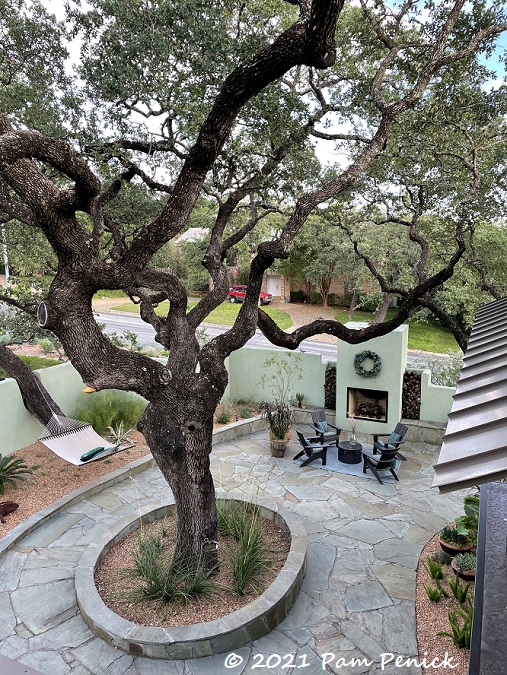
The result is a garden that celebrates its trees and makes full use of their shade with seating areas and a hammock. Notice too the generous space for this tree’s root flare rather than paving right around the trunk. That’s critical for a tree’s long-term health. Be sure to consult a certified arborist about gardening around your trees before you start digging or paving, and never pile soil or even excess mulch over a tree’s root zone. Avoid volcano mulching at all costs.
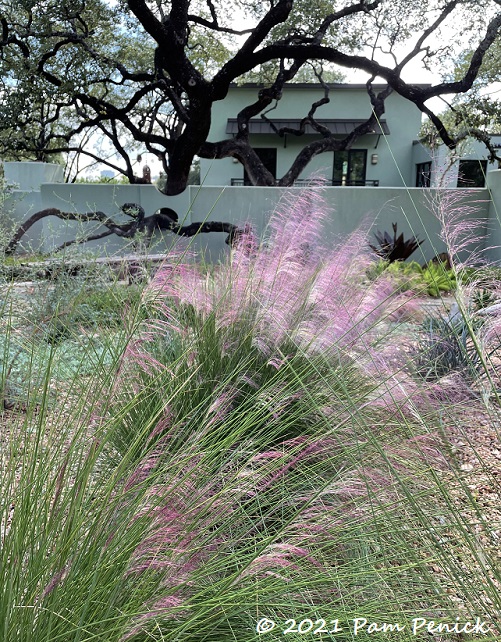
The trees are celebrated in this garden.
Garden in 3-D
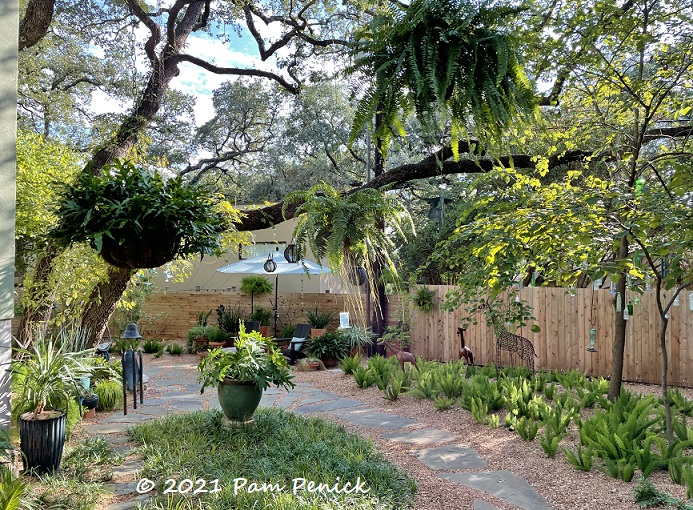
So many of us garden two dimensionally, only planting at ground level. Linda gardens in 3-D. She uses all those trees to lift the eye up with hanging ferns, lanterns, and glass bottles. She places her signature metal animals on tree branches to be discovered. She hangs plants on wire trellises. Up, up, up — you can’t help looking up and seeing that the garden surrounds you above and below. It’s magical. If you don’t have lots of trees you can still do this with arbors, pillars, tuteurs, and pergolas. Get visitors to look up, and your garden expands.
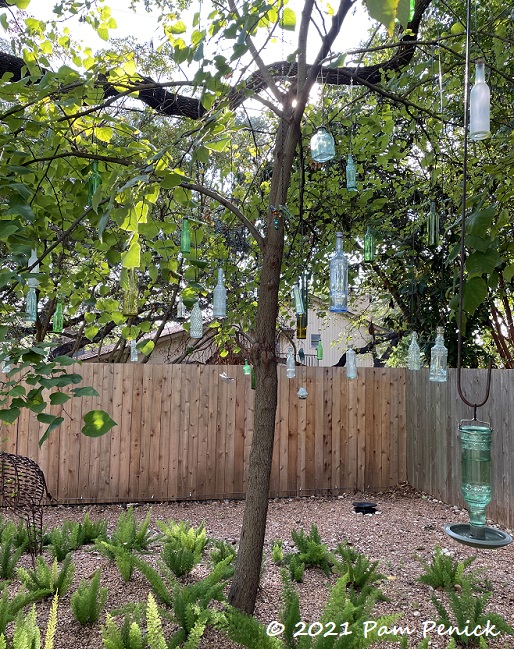
Blue and blue-green bottles dangle from a redbud, catching the light and swaying in the breeze. (When you hang items from trees, don’t wrap wire tightly around branches because as limbs grow, the wire cuts into the wood. I’ve made this mistake, and it can hurt a tree. Here’s advice on hanging objects from trees safely.)
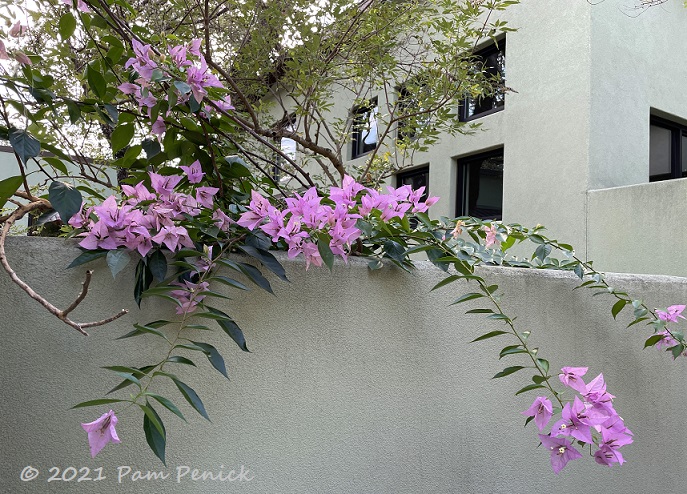
A wall or trellis lets you grow vines or other climbing plants that lift the eye up, like this pink bougainvillea cascading over a minty stucco wall.
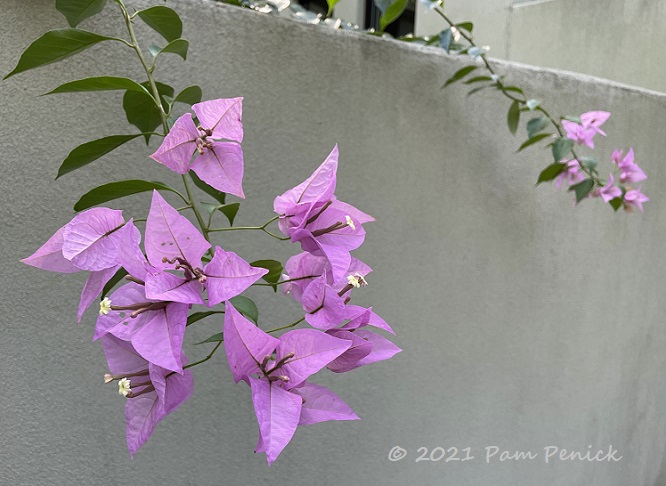
Flowers at eye level
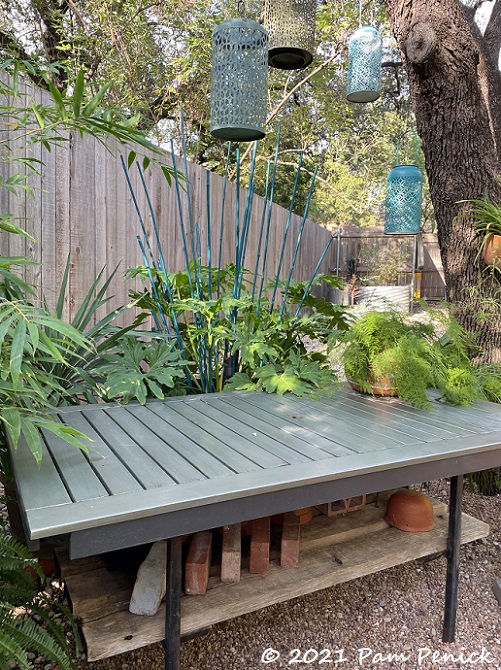
No spot is too mundane to use this trick. Linda hangs lanterns above her potting bench and sticks painted bamboo poles in a pot to occupy vertical space.
Elevate pots
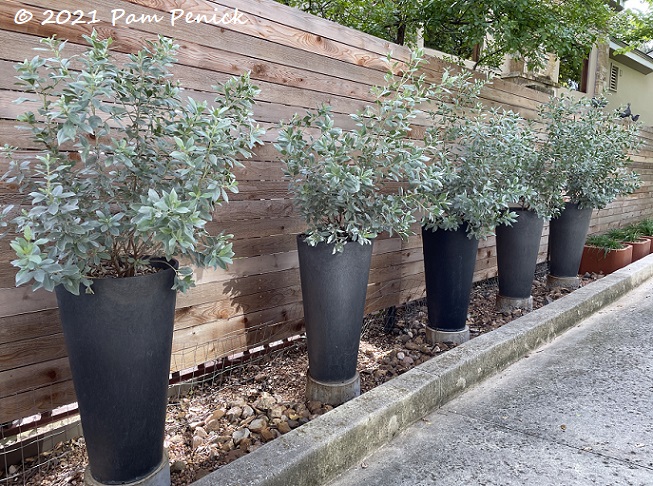
A corollary to “Garden in 3-D” is to elevate pots and plants. Set them off, give them prominence, make them shine. Set pots on plinths and you’ve given them a little stage. It gives smaller pots a lift, creates a stable base (especially if you compact a layer of paver base or decomposed granite under the plinth), and provides better drainage than a pot gets from sitting in the dirt. You can use anything to lift a pot: cinderblocks, stacks of bricks, stacked square or round concrete pavers, another pot turned upside-down. Linda and Carl used plastic nursery pots or buckets and QUIKRETE mix to turn out bunches of plant pedestals, like these under slender gray pots of silver buttonwood.
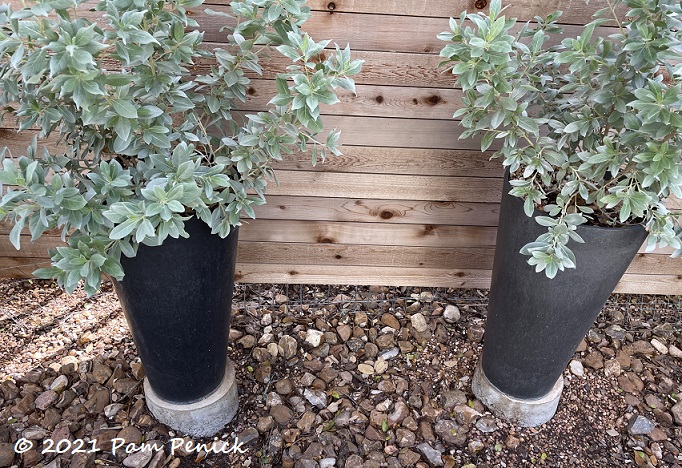
By the way, Linda doesn’t recommend silver buttonwood for San Antonio or Austin because it’s neither cold hardy nor waterwise. She bought it after the big freeze, when she was desperate for a screening replacement along the driveway, but soon learned it’s ill suited for our region. Still, the pot line-up à la The Usual Suspects is genius.
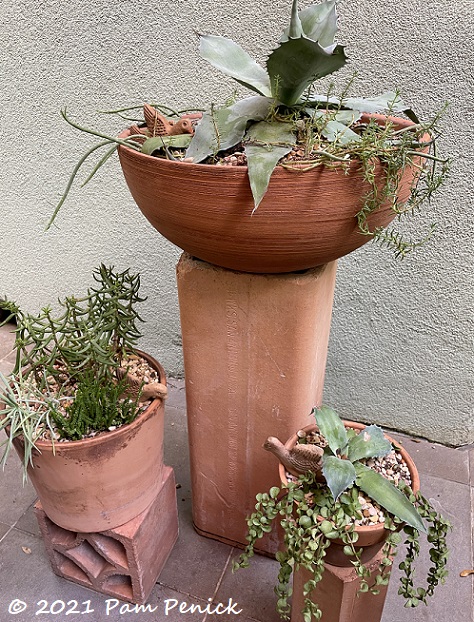
In an interior courtyard, where Linda deviates from her cool blue-and-charcoal color scheme, a trio of terracotta pots sits high on found objects of the same color. The top plant is a pup from my old agave Moby!
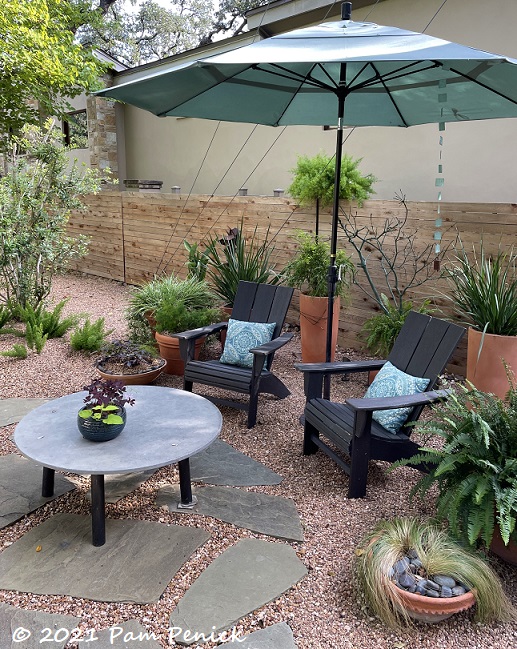
A side garden sitting area gets a sense of enclosure and greenery at eye level thanks to tall pots elevating evergreen plants.
Mass plants and pots
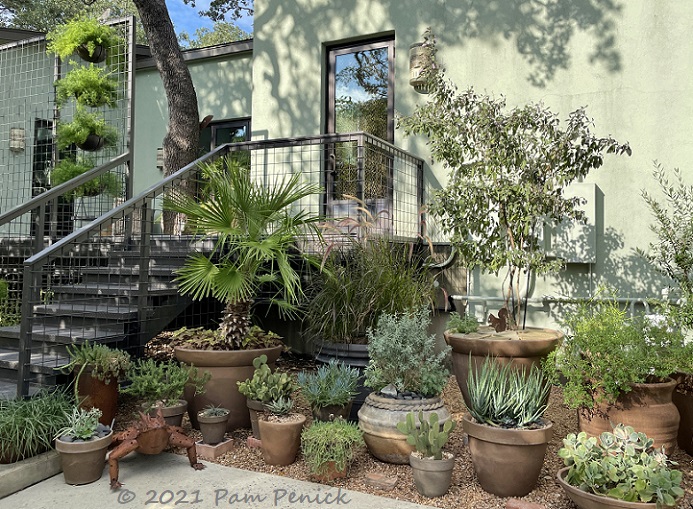
Even in a garden restrained in terms of use of negative space, like Linda’s, more can still be more. She masses similarly colored pots throughout her garden to create striking container gardens like this one. If you have an area that’s not conducive to planting in the ground, whether on a patio or under trees with lots of surface roots, consider massing pots of low-water plants.
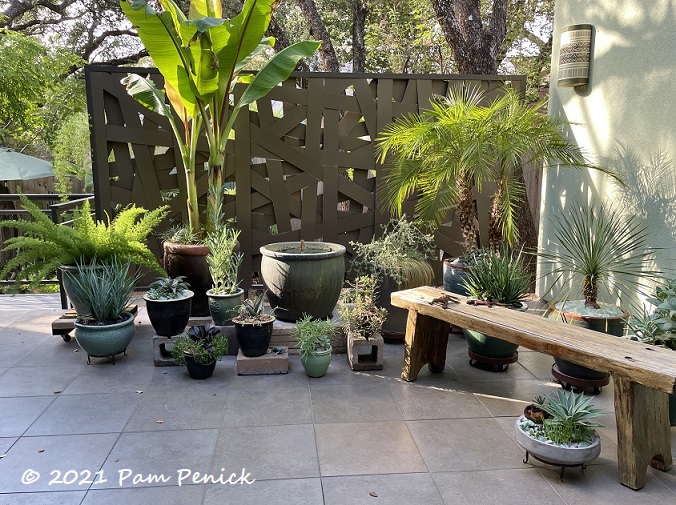
Another group of pots on her patio
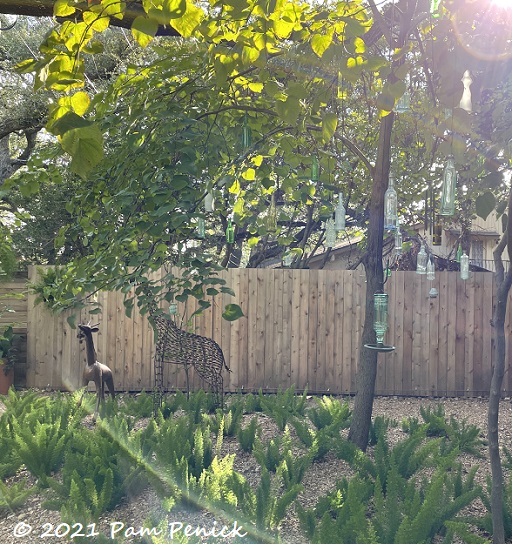
A mass planting of foxtail ferns creates a serene field under a redbud. Plant diversity is a worthy goal, but sometimes so is going all-in on one plant in a particular space to create a calming effect. It’s what a well-designed lawn can bring to the center of a jam-packed garden, but you don’t have to use turf grass. Consider other ground-covering plants that use less water and don’t need mowing.
Stick to a color scheme
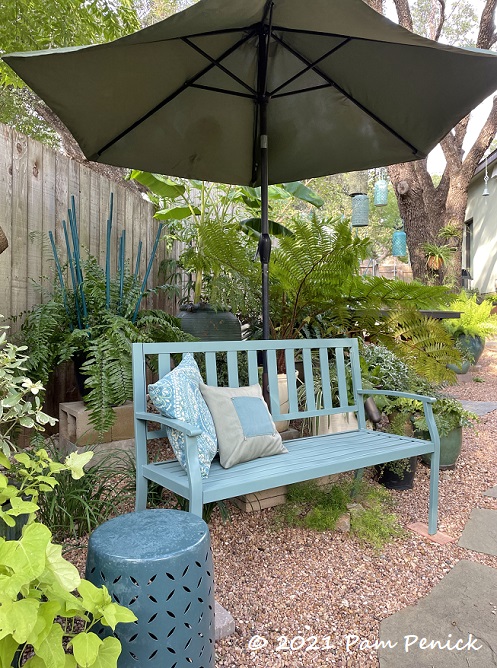
Like the use of negative space and plant massing, sticking with a deliberate color palette requires discipline. But the payoff can be so good. For the majority of her gardens, Linda adheres to blue-greens and charcoal in furnishings, decorative objects, stone paving, wall color, and even many of her plants (dry-climate plants run to silvery greens, and live oak trunks are charcoal). The result is a soothing, cool-feeling, cohesive space, where the garden feels curated and thought-out.
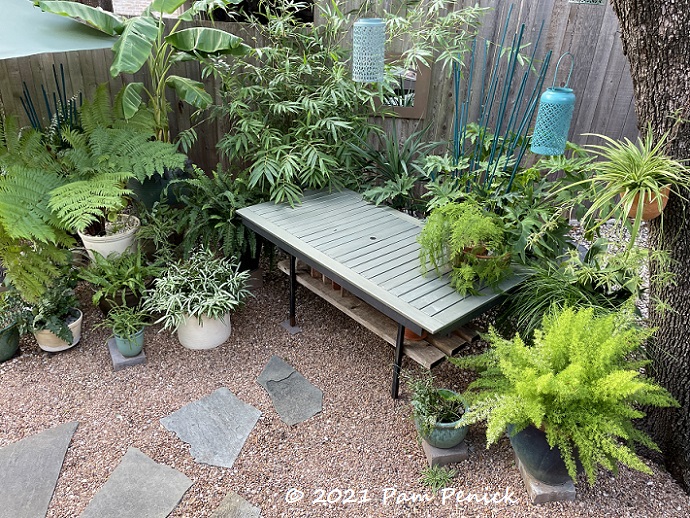
Even Linda’s potting-bench workspace shows her adherence to her favored color scheme of blue-green and dark gray.
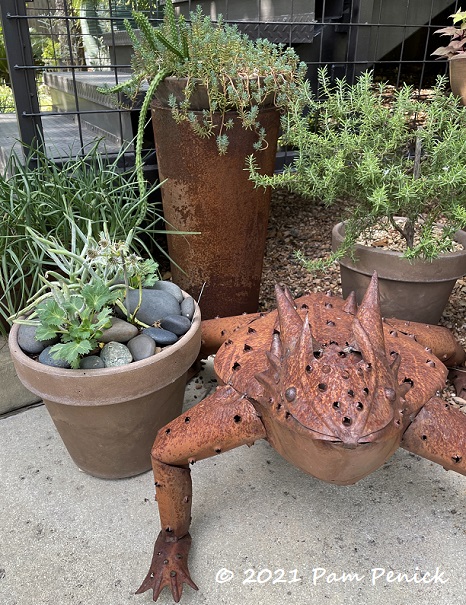
One collection of pots and garden art harmonizes with brown terracotta with rusty metal.
Make lots of inviting sitting spots
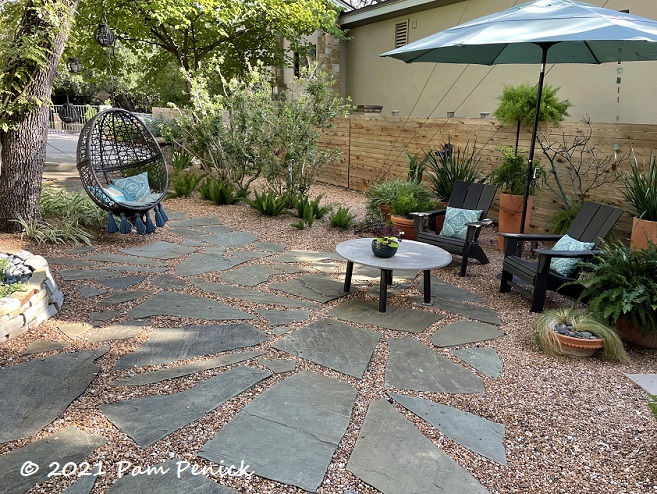
A home garden should feel inviting, offering up multiple spots to settle in, whether for the owner by herself or with a friend or for a small group. Even larger groups of visitors can be accommodated with various small seating areas to spread out in. I love the way Linda enlarged a bend in a side-garden path by adding more stepping stones set in pea gravel, and voila! A patio is formed, perfect for a pair of Adirondacks and an umbrella, with a hanging egg chair opposite a round coffee table.
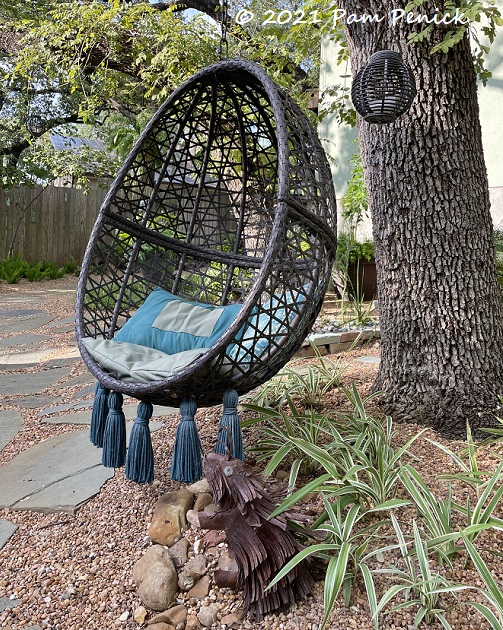
A comfy-looking egg chair hangs from a tree and is echoed by a round hanging lantern.
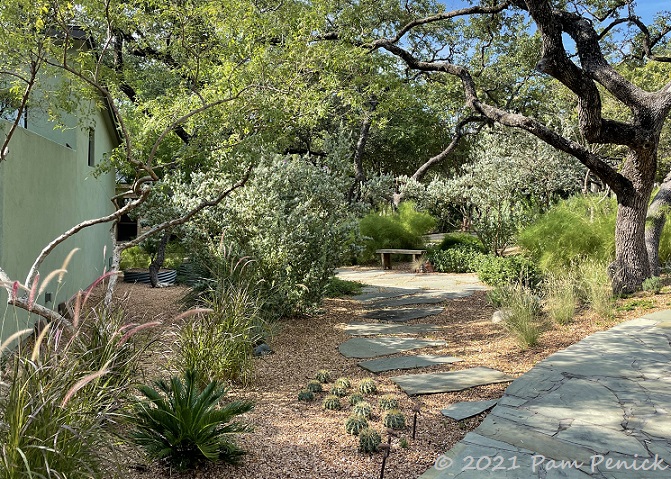
Or how about this tempting little side path in the front garden, which leads over to a solitary wooden bench snuggled into a cloud of bamboo muhly? Again, the stepping-stone path widens in front of the bench, which sits at the curve of the path as it disappears to the left. The bench patio makes a focal point, offers a private spot to sit and rest, and creates a bit of negative space.
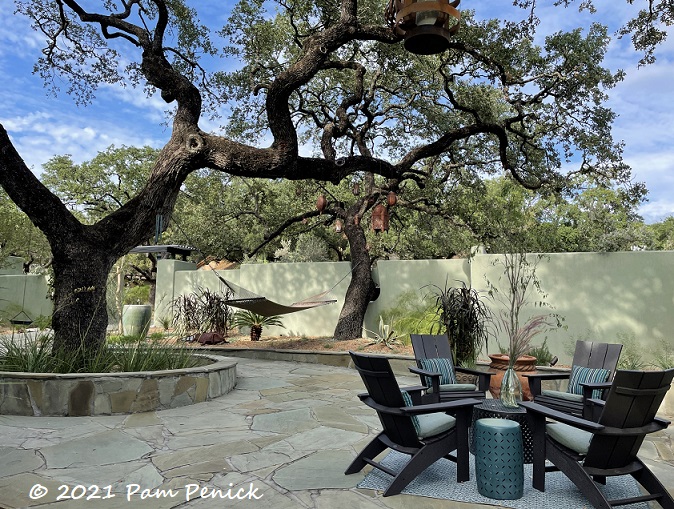
Linda’s most formal sitting space is the paved patio inside her front-courtyard’s walls. A fireplace (at right, not pictured) encourages gatherings even in winter. Generous paving and seat-height retaining walls provide room for larger groups.
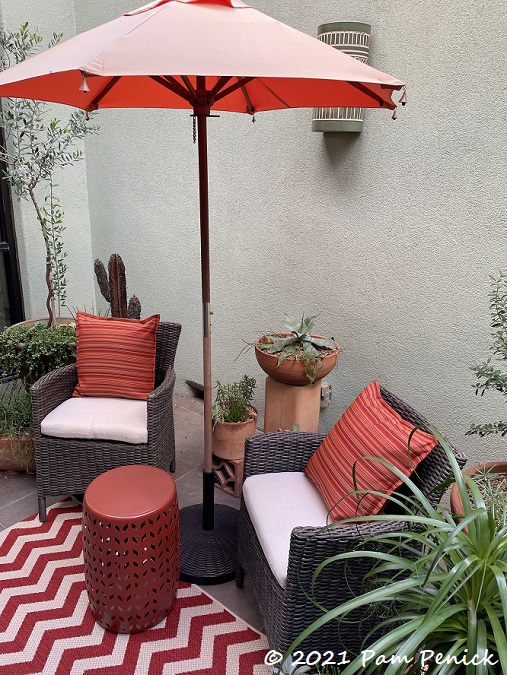
Her interior courtyard, right off the main bedroom, offers space for two chairs, an umbrella, and a little table decorated in warm orange-red.
Unify the dry garden with pea gravel for paths and mulch
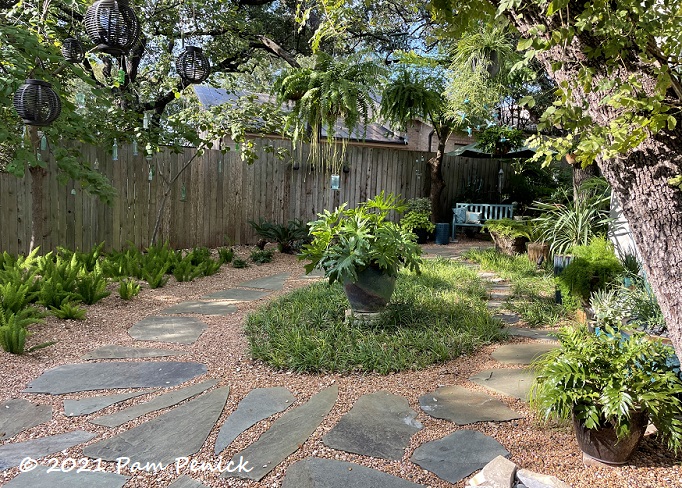
A warm pea gravel makes a unifying field in Linda’s garden for both paths (around stepping stones) and mulch around her plants. By using gravel everywhere, she eliminates the need for edging between gravel paths and wood-mulched beds, and her garden looks more expansive and less fussy as a result.
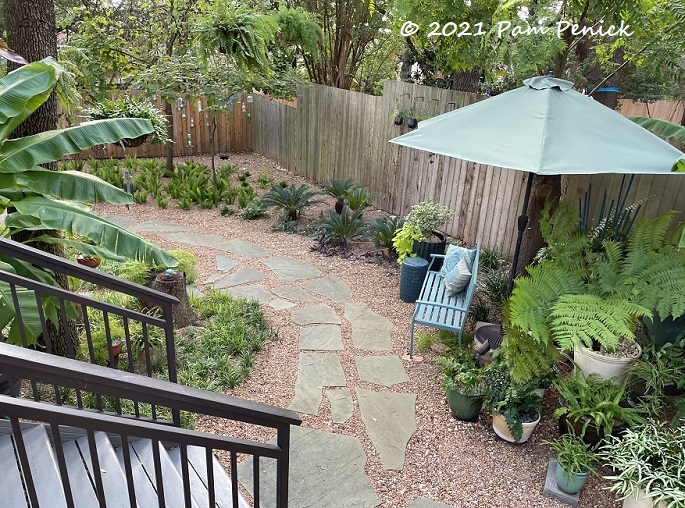
In Austin a lot of gardeners like to use decomposed granite for this same effect, and it can work well. But DG is also a perfect medium for weeds and other plants to self-sow in, so you’ve got to be prepared to do a lot of weeding. Also, DG tends to erode on slopes when it rains. Consider pea gravel instead, but for pathways be sure to install it correctly, in a thin layer on top of a compacted surface. If spread too thick, you’ll find it’s a slog to walk on.
Make your own garden art
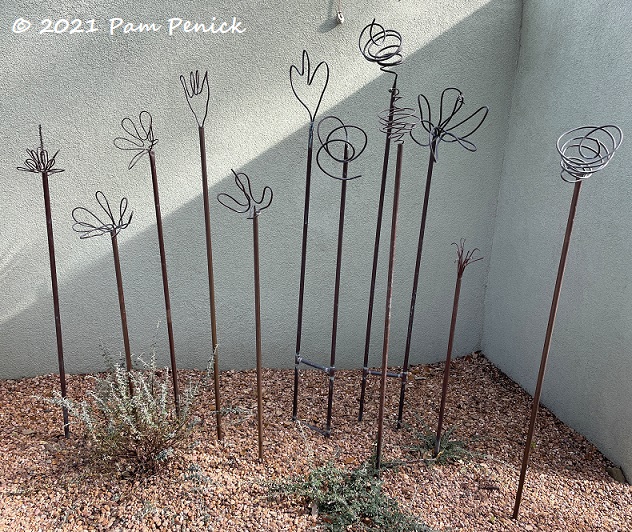
Linda isn’t afraid to make her own garden art. I’ve always admired these copper flowers, which she whips out by bending flexible copper tubing into flower shapes and sticking them into copper pipes (the stems) at various heights. They look especially good with a solid painted background so the delicate shapes stand out.
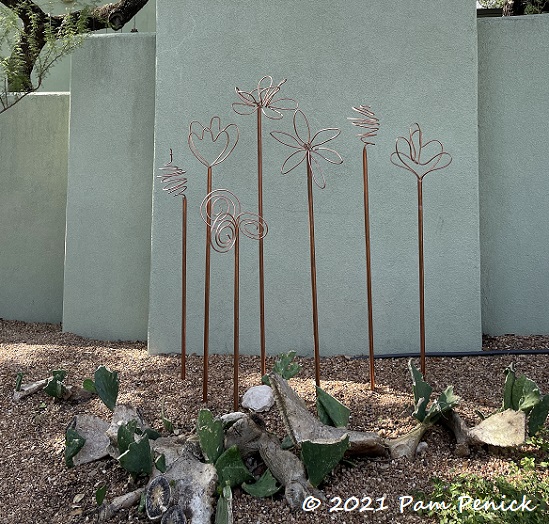
On this visit I noticed she’d made more. She said they are to fill a gap along a wall where an enormous prickly pear was killed to the roots during the February freeze. As the prickly pear grows back, the flowers provide something to look at.
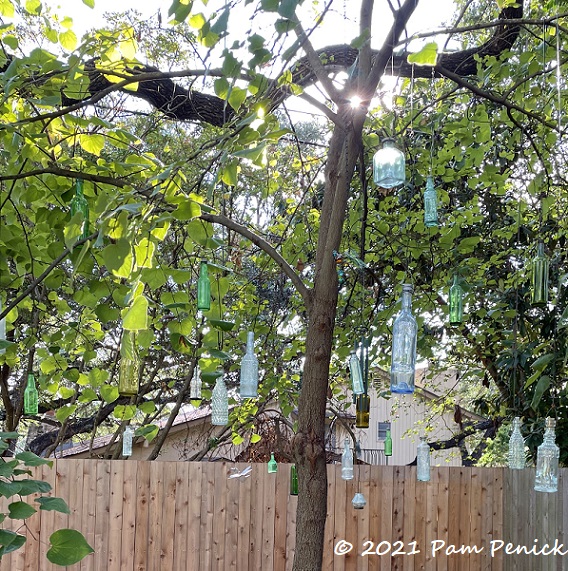
Her tree of hanging bottles is another example of making your own garden art. This tradition goes way back to early African-American communities in the South, and possibly older cultures, according to Felder Rushing.
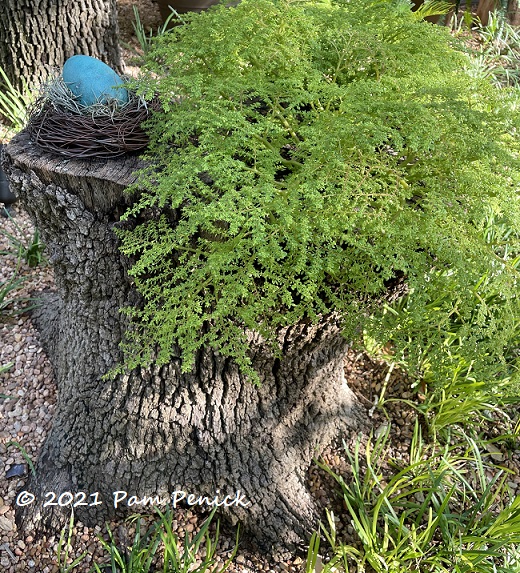
A stumpery of sorts is made from a fern planted in a hollow stump, with a blue egg in a nest as a colorful accent.
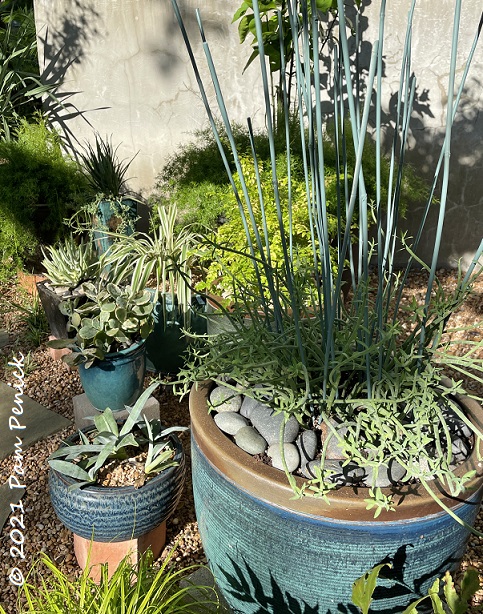
Garden art can be as simple as spray-painted bamboo stuck in a pot.
Have fun with garden art
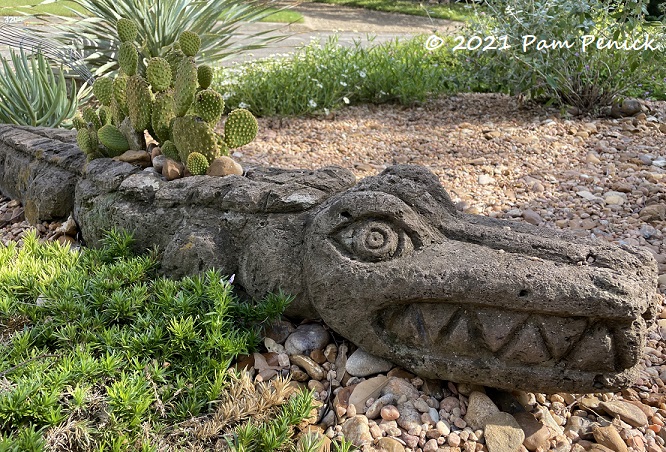
When decorating your garden, choose what delights you, not what you think the neighbors expect or you’d see in a magazine. For Linda, a metal and stone menagerie of exotic animals lives in her garden, and whenever I spot one I’m delighted. She has two stone crocodiles, this one planted with a little prickly pear…
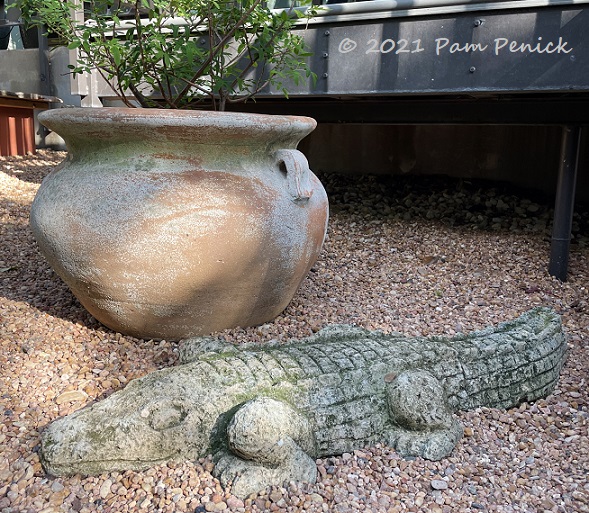
…and this purely decorative one — unless he doubles as a boot scraper or something!
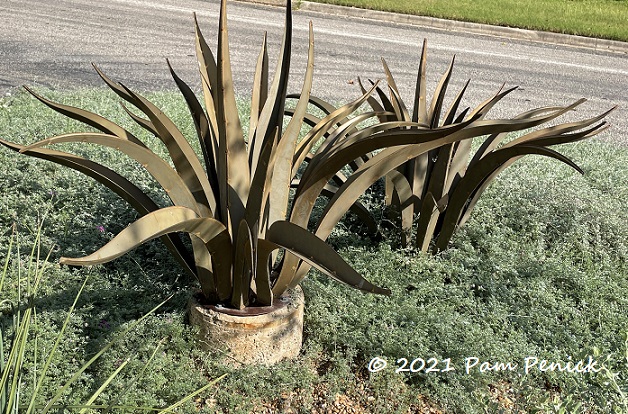
She also collects a number of metal desert plants, like these steel octopus agaves. They make lovely accents and can sub in to replace a focal point plant if, say, an insane freeze comes along and kills the real thing.
Invite people over
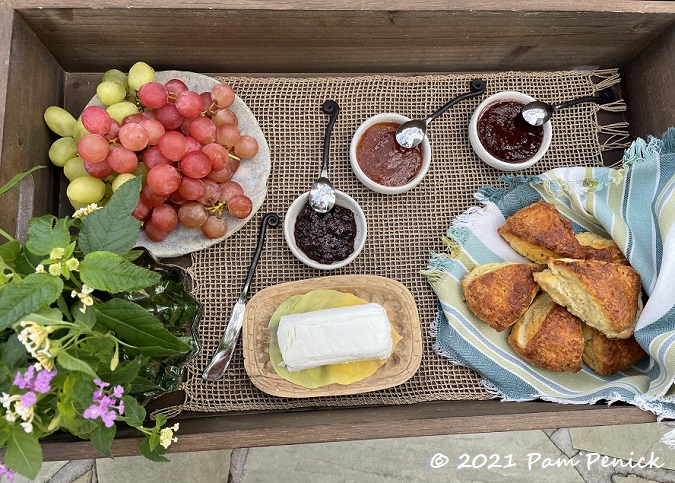
The last way in which Linda’s garden continues to inspire me is through her hospitality. Getting invited to her garden is a real treat, not only visually but gastronomically. She makes one feel special through the inviting spaces she’s created and by bringing out a little tray of something delicious, like these homemade rosemary scones (made by her talented daughters, Demi and Sam), appealingly arranged with a trio of jams, goat cheese, and grapes. So good!
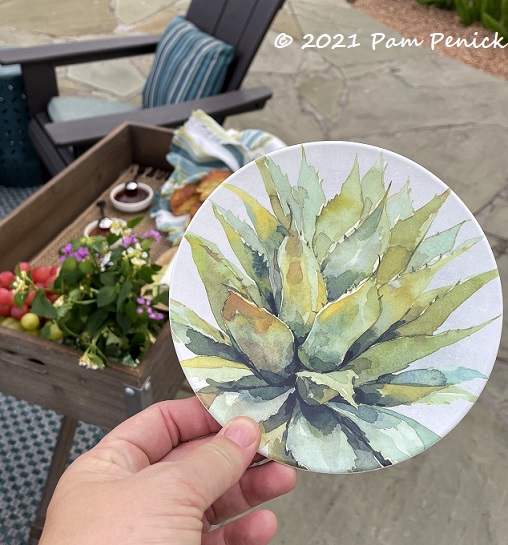
Agave plates are the perfect finishing touch for her garden party.
I hope these techniques I’ve seen used to great effect in Linda’s garden help you conceive of design ideas for your own. Your garden may not be a gravel garden, or a dry garden, or even a Texas garden. But a cohesive and thoughtful space like this one offers inspiration for anyone. Go have fun!
__________________________
Digging Deeper
Want the dirt on dirt? Come learn from horticulturist Matt Welch on Thursday, Nov. 11th at 7pm at Barton Springs Nursery’s beautiful outdoor classroom. His talk is Terra Laboriosus: Taking the “Difficult” Out of Difficult Soils – “Becoming a soil guru is easier than you think, you just have to know where to start: Earth approximately 3 billion years ago. Take a quick journey through time, looking at the cast of characters and events that turned a lifeless rock into a thriving green paradise, with a focus on the birth and evolution of soil. Once you understand how the planet did it, you will see just how easy it is to improve upon the model and create deep, rich, shockingly productive garden soil. We will look at three plants in the Hill Country that exemplify the 5 factors of soil production, and how you can mimic and improve their techniques in your own garden. Learn the various ways we diligently and unknowingly halt soil-forming processes in our landscapes and how to reverse those habits without sacrificing beauty.” Tickets are $10. Purchase in advance at the nursery or by emailing [email protected] or calling 512-328-6655.
Need design help with your yard? Hire me as your personal garden coach! Maybe you need replacement plant ideas after the big freeze. Or maybe your landscaping has grown tired, and you want fresh curb appeal. Or perhaps you’re ready to get rid of some lawn and create a pollinator garden, bird habitat, or hangout space for you and your friends. I’m here to help! Contact me to let me know what’s going on, and let’s figure it out together. My range is Austin and suburbs within a 25-min. drive of NW Austin, but I’m flexible and can travel farther with a surcharge, so let me know where you are. Weekday morning appts. only.
Come learn about gardening and design at Garden Spark! I organize in-person talks by inspiring designers, landscape architects, authors, and gardeners a few times a year in Austin. These are limited-attendance events that sell out quickly, so join the Garden Spark email list to be notified in advance; simply click this link and ask to be added. Season 8 kicks off in fall 2024. Stay tuned for more info!
All material © 2025 by Pam Penick for Digging. Unauthorized reproduction prohibited.


As beautiful as ever. Linda has the perfect eye for what looks good without overdoing it. And the little touches. I noticed the little bells on each rib of the umbrella. So charming. Thanks for taking us along Pam.
Linda does have an excellent eye. It’s a pleasure to see how she puts everything together in her garden.
Fabulous garden, and your knowing commentary is much appreciated!
Thanks, Denise. I’m glad you enjoyed it!
I recognize that wonderful concrete wall, designed to accommodate the large oak tree, on sight – it’s truly remarkable. Thank you for sharing this view of Linda’s garden and your takeaways from the lessons you took away upon viewing it again. There’s a lot to learn there. I loved the sculptures, especially the rusted metal horned toad (?) sitting among a covey of pots.
I could do a whole post just on her garden menagerie, Kris. I love her metal and stone animals, and they fit so perfectly into her garden rooms.
Your commentary brings unnoticed items to my attention! A wonderful review!
Thank you, Nancy! I’m happy to be able to share Linda’s lovely garden.
What a beautiful garden; it’s wonderful to see it again and experience the changes. I imagine the owner might miss some of the plants that were damaged, but she’s done an amazing job of working with the survivors to create a gorgeous space. Thank you for so thoughtfully pointing out the design ideas – it’s great inspiration!
You’re welcome, Maggie. Thanks for your comment. Linda’s place is truly an inspiration.
Thank you for spotlighting this beautiful garden! I love all the little vignettes. Art mingled with the plants, fantastic!
I’m so glad you enjoyed the garden post, Eileen. 🙂
Wow! That’s fabulous. Any chance Linda would tell us what color her house is painted? I’ve been looking for exactly that shade of neutral blue green.
It’s a lovely color, isn’t it? And she found the perfect flagstone to match.
Happy to share the paint color, although I’m afraid it may no longer be available after 15 years…It was a Ralph Lauren shade called “Faded Silk” and I believe at that time it was carried by Lowes. Good luck!
Thanks for sharing, Linda. Melynda, if you look up that paint online you’ll find the color formula for it, and any paint store should be able to color match it for you. https://www.myperfectcolor.com/paint/102119-ralph-lauren-vm113-faded-silk
This is so beautiful, and I especially like the hanging ferns and other “art”. I have pea gravel in part of my yard under a a little grove of live oaks – I decided to embrace the shade. I had shoulder surgery this fall and haven’t been able to clip the root suckers…….. they are trying to overtake everything. Everything in time, and I’ll have that as a winter project this year, with these gorgeous photos to inspire me!
I’m glad you enjoyed the post, Chris. And darn those oak suckers! The bane of my existence too.
I feel so lucky to have been right there with you as we explored the latest incarnation of this beautiful garden. Linda is a natural at creating an inviting and elegant space.
It was so great to be able to see Linda’s garden with you, Loree. What a whirlwind trip that day you arrived, eh?
Oh I love every aspect of Linda’s gorgeous gardens: the color, the quiet, the whimsy, the charm, the cool, the comfort, the lovely array of pots and plants and beauty all around captured exquisitely of course by Pam!
You’ve hit on the beautiful qualities of Linda’s garden, Lucinda. Thanks for your kind comment!
Wow, what a fantastic garden. It’s such fun to see gardens that are SO different from those here in New England. She certainly has made the most of everything, even down to the tiniest touches. Thanks for sharing these wonderful photos!
It was my pleasure, Ellie. Thanks for reading!
What a joyful and creative way to recover from frost damage! Lots of good ideas to consider.
Yes, this garden is full of good ideas. Thanks, Diana.
We recently had a serious drainage issue corrected at our home in Dallas, and the process resulted in the loss of many of my longtime shrubs and plants and in long strips of gravel in front of the house that offer the opposite of curb appeal. After my initial shock and depression, I wondered if I might embrace the change and googled “Gravel gardening in Texas,” and this splendid article popped up. Oh my—this is my dream landscape, and so many elements of Linda’s design would work for our midcentury modern home if adapted for our climate zone. Thank you so much for giving me a new lease on my garden life!
This is the best kind of comment. Thank you, Judy. I do hope this post and Linda’s beautiful example help you to embrace the change to your own garden. It sounds like you’re well on your way.